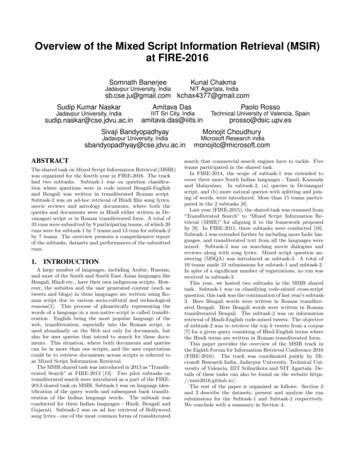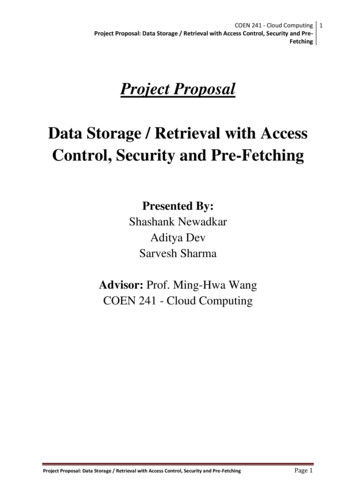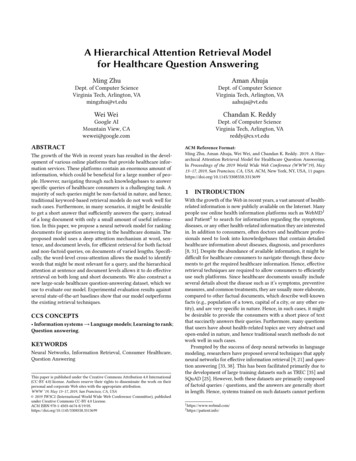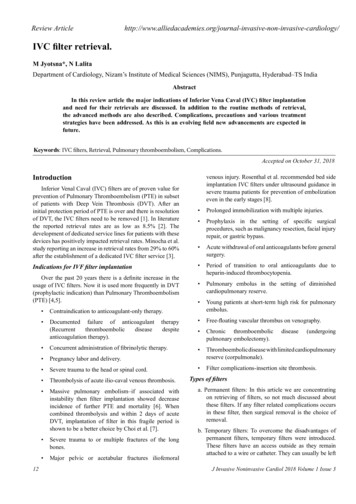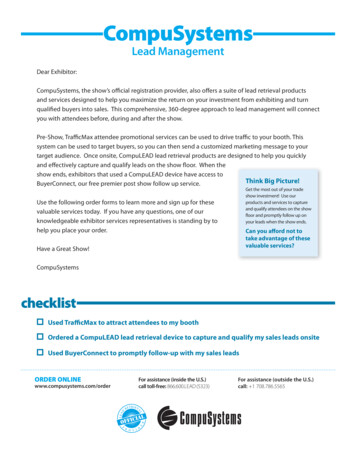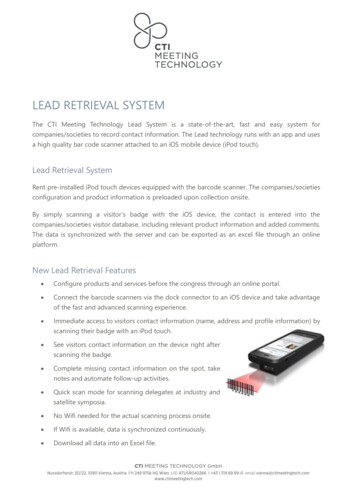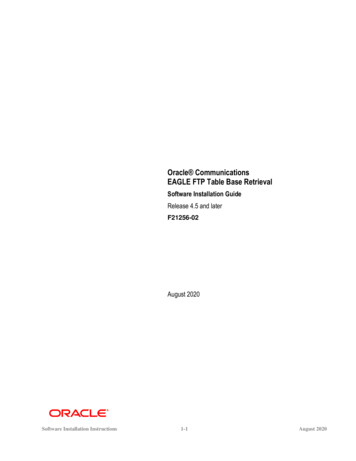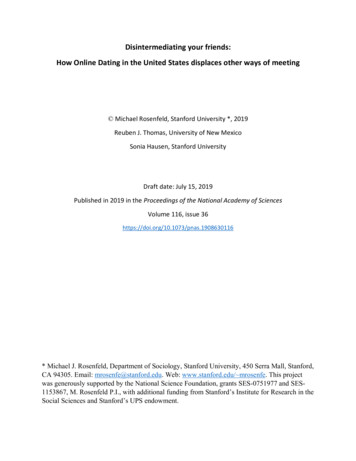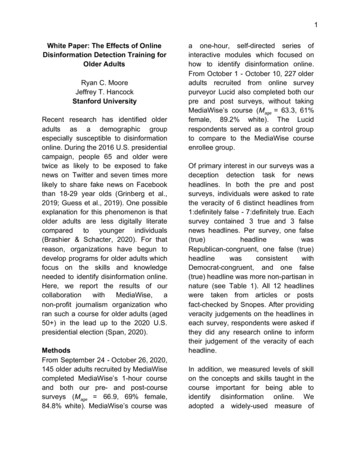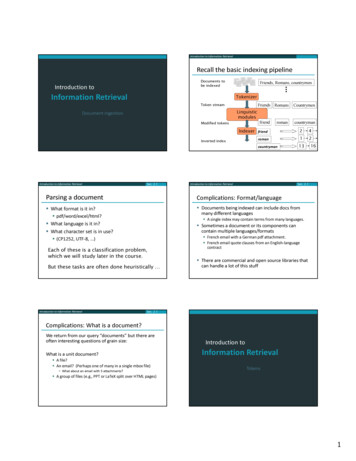
Transcription
Introduction to Information RetrievalIntroduction to Information RetrievalRecall the basic indexing pipelineDocuments tobe indexedIntroduction toInformation RetrievalFriends, Romans, countrymen.TokenizerToken streamFriends RomansCountrymenLinguisticmodulesDocument ingestionfriendModified tokensromancountryman24roman12countryman13Indexer friendInverted indexIntroduction to Information RetrievalSec. 2.1Introduction to Information RetrievalSec. 2.1Parsing a documentComplications: Format/language What format is it in? Documents being indexed can include docs frommany different languages pdf/word/excel/html? A single index may contain terms from many languages. What language is it in? What character set is in use? Sometimes a document or its components cancontain multiple languages/formats (CP1252, UTF-8, )Each of these is a classification problem,which we will study later in the course.But these tasks are often done heuristically Introduction to Information Retrieval16Sec. 2.1 French email with a German pdf attachment. French email quote clauses from an English-languagecontract There are commercial and open source libraries thatcan handle a lot of this stuffIntroduction to Information RetrievalComplications: What is a document?We return from our query “documents” but there areoften interesting questions of grain size:What is a unit document? A file? An email? (Perhaps one of many in a single mbox file) What about an email with 5 attachments?Introduction toInformation RetrievalTokens A group of files (e.g., PPT or LaTeX split over HTML pages)1
Introduction to Information RetrievalSec. 2.2.1Introduction to Information RetrievalTokenizationTokenization Input: “Friends, Romans and Countrymen” Output: Tokens Issues in tokenization: Finland’s capital Finland AND s? Finlands? Finland’s? Hewlett-Packard Hewlett and Packard as twotokens? Friends Romans Countrymen A token is an instance of a sequence of characters Each such token is now a candidate for an indexentry, after further processing Described below state-of-the-art: break up hyphenated sequence.co-educationlowercase, lower-case, lower case ?It can be effective to get the user to put in possible hyphens San Francisco: one token or two? But what are valid tokens to emit? How do you decide it is one token?Introduction to Information RetrievalSec. 2.2.1Numbers Sec. 2.2.1Introduction to Information RetrievalSec. 2.2.1Tokenization: language issues3/20/91Mar. 12, 199120/3/9155 B.C.B-52My PGP key is 324a3df234cb23e(800) 234-2333 Often have embedded spaces Older IR systems may not index numbers French L'ensemble one token or two? L ? L’ ? Le ? Want l’ensemble to match with un ensemble Until at least 2003, it didn’t on Google Internationalization! But often very useful: think about things like looking up errorcodes/stacktraces on the web (One answer is using n-grams: IIR ch. 3) Will often index “meta-data” separately Creation date, format, etc. German noun compounds are not segmented Lebensversicherungsgesellschaftsangestellter ‘life insurance company employee’ German retrieval systems benefit greatly from a compound splittermodule Can give a 15% performance boost for GermanIntroduction to Information RetrievalSec. 2.2.1Introduction to Information RetrievalSec. 2.2.1Tokenization: language issuesTokenization: language issues Chinese and Japanese have no spaces betweenwords: Arabic (or Hebrew) is basically written right to left,but with certain items like numbers written left toright Words are separated, but letter forms within a wordform complex ligatures �里达。 Not always guaranteed a unique tokenization Further complicated in Japanese, with multiplealphabets intermingled Dates/amounts in multiple あた HiraganaKanjiRomajiEnd-user can express query entirely in hiragana! start ‘Algeria achieved its independence in 1962 after 132years of French occupation.’ With Unicode, the surface presentation is complex, but thestored form is straightforward2
Introduction to Information RetrievalIntroduction to Information RetrievalSec. 2.2.2Stop words With a stop list, you exclude from the dictionaryentirely the commonest words. Intuition:Introduction to They have little semantic content: the, a, and, to, be There are a lot of them: 30% of postings for top 30 wordsInformation Retrieval But the trend is away from doing this:TermsThe things indexed in an IR system Good compression techniques (IIR 5) means the space for includingstop words in a system is very small Good query optimization techniques (IIR 7) mean you pay little atquery time for including stop words. You need them for: Phrase queries: “King of Denmark” Various song titles, etc.: “Let it be”, “To be or not to be” “Relational” queries: “flights to London”Introduction to Information RetrievalSec. 2.2.3Introduction to Information RetrievalSec. 2.2.3Normalization to termsNormalization: other languages We may need to “normalize” words in indexed textas well as query words into the same form Accents: e.g., French résumé vs. resume. Umlauts: e.g., German: Tuebingen vs. Tübingen We want to match U.S.A. and USA Should be equivalent Result is terms: a term is a (normalized) word type,which is an entry in our IR system dictionary We most commonly implicitly define equivalenceclasses of terms by, e.g., Most important criterion: How are your users like to write their queries for thesewords? Even in languages that standardly have accents, usersoften may not type them deleting periods to form a term U.S.A., USA USA Often best to normalize to a de-accented term deleting hyphens to form a term Tuebingen, Tübingen, Tubingen Tubingen anti-discriminatory, antidiscriminatory antidiscriminatoryIntroduction to Information RetrievalSec. 2.2.3Introduction to Information RetrievalNormalization: other languagesCase folding Normalization of things like date forms Reduce all letters to lower case 7月月30日日 vs. 7/30 Japanese use of kana vs. Chinese characters Tokenization and normalization may depend on thelanguage and so is intertwined with languagedetectionIs thisMorgen will ich in MIT German “mit”? Crucial: Need to “normalize” indexed text as well asquery terms identicallySec. 2.2.3 exception: upper case in mid-sentence? e.g., General Motors Fed vs. fed SAIL vs. sail Often best to lower case everything, since users will uselowercase regardless of ‘correct’ capitalization Longstanding Google example:[fixed in 2011 ] Query C.A.T. #1 result is for “cats” (well, Lolcats) not Caterpillar Inc.3
Introduction to Information RetrievalSec. 2.2.3Normalization to termsIntroduction to Information RetrievalThesauri and soundex Do we handle synonyms and homonyms? E.g., by hand-constructed equivalence classes An alternative to equivalence classing is to doasymmetric expansion An example of where this may be useful Enter: window Enter: windows Enter: Windows car automobilecolor colour We can rewrite to form equivalence-class terms When the document contains automobile, index it under carautomobile (and vice-versa)Search: window, windowsSearch: Windows, windows, windowSearch: Windows Or we can expand a query When the query contains automobile, look under car as well What about spelling mistakes? Potentially more powerful, but less efficient One approach is Soundex, which forms equivalence classesof words based on phonetic heuristics More in IIR 3 and IIR 9Introduction to Information RetrievalIntroduction to Information RetrievalSec. 2.2.4Lemmatization Reduce inflectional/variant forms to base form E.g.,Introduction to am, are, is beInformation Retrieval car, cars, car's, cars' car the boy's cars are different colors the boy car bedifferent colorStemming and Lemmatization Lemmatization implies doing “proper” reduction todictionary headword formIntroduction to Information RetrievalSec. 2.2.4Introduction to Information RetrievalStemmingPorter’s algorithm Reduce terms to their “roots” before indexing “Stemming” suggests crude affix chopping Commonest algorithm for stemming English language dependent e.g., automate(s), automatic, automation all reduced toautomat.for example compressedand compression are bothaccepted as equivalent tocompress.for exampl compress andcompress ar both acceptas equival to compressSec. 2.2.4 Results suggest it’s at least as good as other stemmingoptions Conventions 5 phases of reductions phases applied sequentially each phase consists of a set of commands sample convention: Of the rules in a compound command,select the one that applies to the longest suffix.4
Introduction to Information RetrievalSec. 2.2.4Introduction to Information RetrievalTypical rules in Porter Sec. 2.2.4Other stemmerssses ssies iational atetional tion Other stemmers exist: Lovins stemmer mming/general/lovins.htm Single-pass, longest suffix removal (about 250 rules) Paice/Husk stemmer Snowball Weight of word sensitive rules (m 1) EMENT Full morphological analysis (lemmatization) At most modest benefits for retrieval replacement replac cement cementIntroduction to Information RetrievalSec. 2.2.4Introduction to Information RetrievalSec. 2.2.4Language-specificityDoes stemming help? The above methods embody transformations thatare English: very mixed results. Helps recall for somequeries but harms precision on others Language-specific, and often Application-specific E.g., operative (dentistry) oper Definitely useful for Spanish, German, Finnish, These are “plug-in” addenda to the indexing process Both open source and commercial plug-ins areavailable for handling theseIntroduction to Information Retrieval 30% performance gains for Finnish!Introduction to Information RetrievalSec. 2.3Recall basic merge Walk through the two postings simultaneously, intime linear in the total number of postings entriesIntroduction toInformation RetrievalFaster postings merges:Skip pointers/Skip lists282484112384811641712821Brutus31 CaesarIf the list lengths are m and n, the merge takes O(m n)operations.Can we do better?Yes (if the index isn’t changing too fast).5
Introduction to Information RetrievalSec. 2.3Augment postings with skip pointers(at indexing time)1284124841238Sec. 2.3Query processing with skip pointers128414864128231111Introduction to Information Retrieval11484123821311 Why? To skip postings that will not figure in the searchresults. How? Where do we place skip pointers?Introduction to Information RetrievalSec. 2.3641283111174811172131Suppose we’ve stepped through the lists until weprocess 8 on each list. We match it and advance.We then have 41 and 11 on the lower. 11 is smaller.But the skip successor of 11 on the lower list is 31, sowe can skip ahead past the intervening postings.Introduction to Information RetrievalSec. 2.3Where do we place skips?Placing skips Tradeoff: Simple heuristic: for postings of length L, use Levenly-spaced skip pointers [Moffat and Zobel 1996] This ignores the distribution of query terms. Easy if the index is relatively static; harder if L keepschanging because of updates. More skips shorter skip spans more likely to skip.But lots of comparisons to skip pointers. Fewer skips few pointer comparison, but then long skipspans few successful skips. This definitely used to help; with modern hardware itmay not unless you’re memory-based [Bahle et al. 2002] The I/O cost of loading a bigger postings list can outweighthe gains from quicker in memory merging!6
dictionary headword form Sec. 2.2.4 Introduction to Information Retrieval Stemming Reduce terms to their “roots” before indexing “Stemming” suggests crude affix chopping language dependent e.g., automate(s), automatic, automation all reduced to automat. for example compressed and compression are both accepted as equivalent to compress .
